Back in the ‘80s I had a bit of an interest in alternative medicine, and I came across a book called “The Wheatgrass Book: How to Grow and Use Wheatgrass to Maximize Your Health and Vitality” by a lady by the name of Ann Wigmore. I bought a copy but did not find the thought of actually swallowing wheatgrass juice to be all that attractive, so I never really got into it. Plus, it was touted as the cure for a long list of diseases, which sounded dodgy at best. (I went looking for the book recently but couldn’t find it so I must have gotten rid of it in the intervening years.)
There are studies available on the net that allude to the possibility of good things coming from consuming it. From eliminating toxins and helping digestion to boosting the immune system and helping with diabetes and even cancer, but the reports are usually tempered with the word ‘may’ and end by saying that more research is needed.
What seems clear cut is that wheat grass juice does contain calcium, iron, magnesium, phytonutrients, 17 amino acids and vitamins A, C, E, K, and B complex, plus some other bits and pieces. So it seems that it is a bit of a vitamin pill, contained in green sludge. Winner.
We keep organic wheat grain around which we use to grind for flour, so we have a ready supply of the wheat grass raw material and so wheat grass juice would be considerably cheaper than vitamin pills should we ever need them. That assumes I could stomach the stuff (it has long been an assertion of mine that these things are good for you only if you can keep them down) so a small-scale experiment was in order.
I have seen a number of suggestions about growing the stuff, but here is what I did, and it appeared to work OK –
1. the container I used was a plastic takeaway container, the bottom of which I punched some holes in using a pad punch, to allow drainage. There was a depression running around the edge of the bottom of the container which I left intact so that it could retain a bit of water as a reservoir. Probably not critical, but that was my thinking at the time.
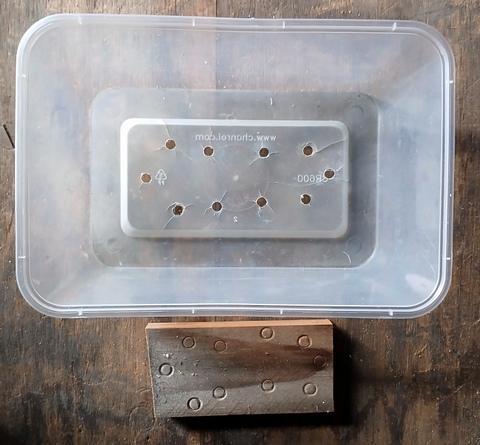
2. Into the container I filled my standard seed raising/potting mix which consists of (by volume): one part coarse sand, two parts sieved compost or worm castings and three parts cocopeat. Mixed all together and then placed in the container until it was almost full.

3. I soaked about a quarter cup of wheat grains (berries?) overnight, drained them, rinsed them again and placed them on top of the growing medium as evenly as I could, which wasn’t very! Once they were in place I gave the whole thing a water spray and placed it into my window farm.

4. After about six days the sprouts were up to about 150mm tall so I harvested them with a pair of scissors and then had to work out how to turn wheat grass into juice. There are specific juicers to do just that, but I don’t have one!

5. I decided to use the ‘bullet’ thing that came with our food processor. The harvest weighed 20grams, so I placed in the bullet with ¼ cup of water, assembled things and put it in place. When I turned it on there was plenty of whizzing, but nothing happened. I added another ¼ cup and this time it worked well, filling the bullet with green sludge (sounds appetising, doesn’t it?).
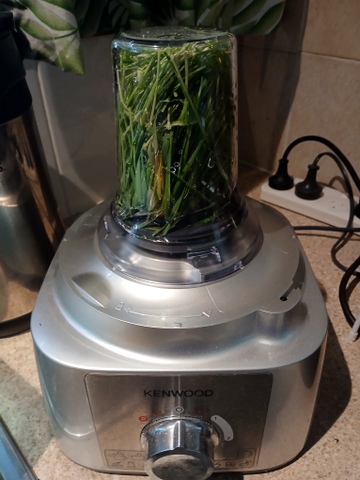
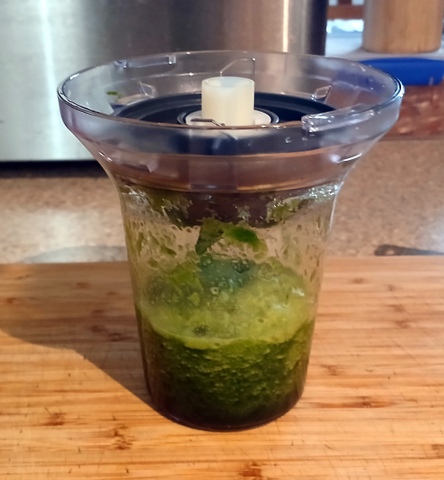
6. I then filtered out the remaining wheatgrass juice from the residue by placing the output of the bullet onto a very fine mesh, home-made veggie bag which was placed in a glass. When the juice was strained out, I squeezed the bag to coax out the remainder of the juice, scoring me half a glass of the stuff, with the green fibrous residue going into the compost.
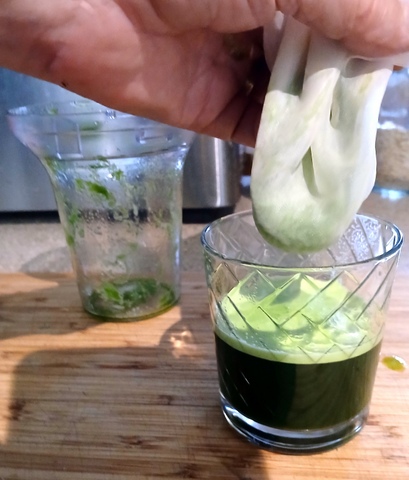
Filtering
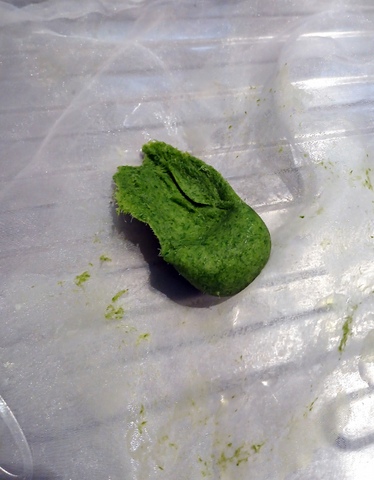
Fibrous residue filtered from the sludge

Yum Yum!
7. The original wheatgrass plants continued to re-grow and were ready for another harvest within a week or so.
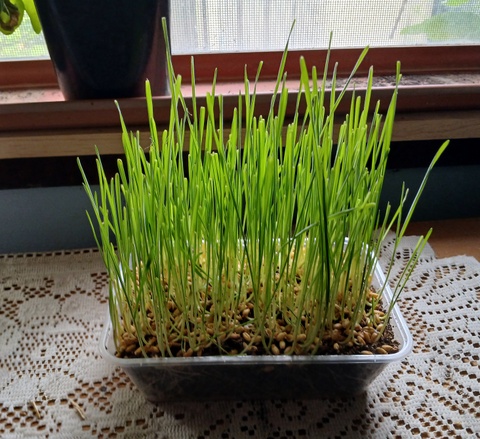
So, how did it taste?
Well, it wasn’t disgusting……….but it wasn’t the greatest thing I have ever tasted either. I think that over time, and maybe with the addition of ice, or some kind of flavouring agent, I could get used to it.
There are some other mild concerns which I read, that consuming wheatgrass juice can cause nausea and difficulty in swallowing (the wheatgrass juice) and contamination with ‘microbials’ is also possible. So just be aware that the consumption of wheatgrass juice, particularly at the start, is not going to be an unalloyed pleasure. The people who know suggest one way around this is to consume it in the morning, an hour or so before eating anything. Just sayin’!
But wait, there’s more!
If, by some chance, you grow your wheatgrass for juice but find you just can’t choke it down, all is not lost. An alternative name for wheatgrass is ‘cat grass’ so you can share the produce with your furry feline friend, particularly if that friend is an ‘indoors’ kind of cat.
There you have it, if you want to grow some wheatgrass, it is quick, easy and cheap to grow, so everybody (even your cat) wins!


